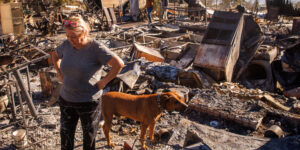Heat scorched Western Europe this July in what will likely be confirmed as the hottest month in recorded history, according to the UN’s World Meteorological Organization.
“This is not your grandfather’s summer,” United Nations Secretary General Antonio Gutierrez said.
 The impact of human activity on the extreme temperatures is the subject of the latest analysis by World Weather Attribution (WWA), a research collaboration that provides near-real-time analysis of climate change’s impact on weather.
The impact of human activity on the extreme temperatures is the subject of the latest analysis by World Weather Attribution (WWA), a research collaboration that provides near-real-time analysis of climate change’s impact on weather.
The group on Friday concluded that human-driven changes to the atmosphere added from 1.5 degrees to 3 degrees Celsius (2.7 to 5.4 Fahrenheit) to the heat wave. Without greenhouse gas emissions, the July heat wave would have had very little chance of occurring at all in France, where temperatures hit 110.5 degrees Fahrenheit outside Paris on July 25.
In a pre-industrial climate, thermometers might reach that high only once every 1,000 years.
“At all locations analyzed, the change in probability of the event is large, and in several cases it is so large that a reliable estimate cannot be established,” write the WWA authors.
The numbers out of Europe are relentless. The Netherlands and Belgium exceeded 40 degrees Celsius (104 Fahrenheit) for the first time last month, and the U.K. set a new record of 38.7 Celsius (101.7 Fahrenheit). The blistering conditions have since moved north, melting parts of Greenland at rates faster than 2012, the worst year on record.
Scientists have gained much more confidence evaluating how climate change may affect an extreme weather event over the last 15 years, although it remains a young field. Researchers are increasingly studying shorter-term events, such as heavy precipitation and tornadoes, said Robert Vautard, a senior scientist at France’s National Center for Scientific Research and a WWA co-author.
The breakthrough came in 2004, when researchers found that climate change had made the previous year’s Western European heat wave about twice as likely to occur as it would have in a world without greenhouse gas pollution.
The 2003 heat wave killed as many as 70,000 people, including more than 15,000 in France.
The continent was better prepared this time around. Governments issued warnings, and public officials advised people how to protect themselves. France elevated the status of its Plan Canicule (Heatwave Plan) to the third highest of four levels on July 22 and helped vulnerable populations prepare for the extreme temperatures.
WWA estimates the increased frequency and intensity of extreme weather by simulating conditions on computer models, and seeing how often they occur in an electronic world that hasn’t warmed 1 degree Celsius since the middle of the 19th century. They throw out models that poorly replicate the temperature extremes.
“It makes our estimate more conservative,” said Friederike Otto, a lead WWA researcher.




















 Embroker CEO Reflects on Tech, Insurance Journey
Embroker CEO Reflects on Tech, Insurance Journey  East Coast High-End Car Theft Ring Busted
East Coast High-End Car Theft Ring Busted  Surviving the ‘Silver Tsunami’: Closing the Talent, Skills Gap in Underwriting
Surviving the ‘Silver Tsunami’: Closing the Talent, Skills Gap in Underwriting  Auto Insurer Files $450M Fraud RICO Case in NY
Auto Insurer Files $450M Fraud RICO Case in NY 




